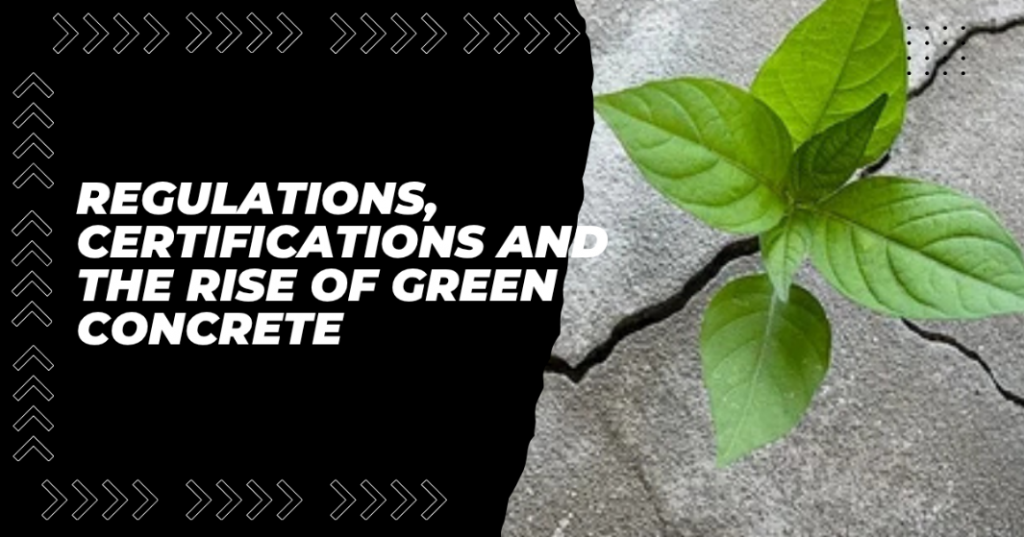Regulations, Certifications and the Rise of Green Concrete in Real-Estate Construction

The building industry is going to be heavily influenced by the trend towards environmentally friendly materials. Among the most significant is the use of green concrete which releases fewer pollutants into the atmosphere than regular concrete. As a result, green concrete is becoming very popular due to the efforts of different players such as governments, organizations and the real-estate sector in leading the way for sustainable construction practices. This article dives into the rules, certifications, and market phenomena that have contributed to the green concrete upheaval in real estate construction.
What is Green Concrete?
Green concrete basically involves the use of earth-friendly materials and techniques for the purpose of reducing its carbon emissions. Whereas a typical concrete still relies heavily on cement which is the most carbon-intensive part of the entire production, green concrete changes the cement with components such as industrial by-products like fly ash, slag or silica fume, recycled aggregates and carbon-consuming compounds. Besides, these substances not only reduce the release of gases during the manufacturing stage but also make the building process eco-friendly.
Regulatory Landscape Driving the Adoption of Green Concrete
Sustainability becoming more and more significant in the building sector has resulted in the imposition of numerous rules and standards to reduce damage to the environment. Authorities worldwide have passed laws to limit the release of carbon gases, with special attention to the cement and concrete industries. The demand for environmentally friendly solutions is becoming clearer every day as the rules require energy-saving, less waste production and the use of materials with a low carbon footprint.
International Standards and Regulations
Various international standards and guidelines have been put in place to regulate the manufacturing and utilization of green concrete. These rules help to maintain the eco-friendliness of the material and also certify its safety and functionality in the building sector. Major standards are:
- ISO 14001 (Environmental Management): The Environmental management system certification standard is one of the ways to make sure that those who produce concrete do not mess up by creating unnecessary waste, increasing carbon emissions and are generally good with the resources.
- LEED (Leadership in Energy and Environmental Design): LEED is a globally known certification program that encourages the use of environmentally beneficial building practices, one of which is green concrete. LEED is able to grant credits if such means of construction are chosen where there is less environmental impact and energy consumption.
- BREEAM (Building Research Establishment Environmental Assessment Method): BREEAM is a leading sustainability certification of the future which worldwide measures the environmental performance of buildings. We promote the use of environmentally friendly materials like green concrete and BREEAM acknowledges the importance of green concrete in the implementation of eco-friendly construction practices.
National and Regional Regulations
Apart from international standards, different countries have set up regulations that are specific to their local environmental objectives. For example, the European Union’s EU Emissions Trading System (EU ETS) limits very strictly the carbon emissions deriving from the industrial processes, among them, the cement production. Correspondingly, in the U.S., the Environmental Protection Agency (EPA) is facilitating the law of several programs that include the reduction of carbon emissions and the usage of sustainable building materials in the construction industry. These rules need to be enforced consistently if the green concrete market is to thrive and thus, there will be a constant demand for low-carbon alternatives.
Certifications for Green Concrete
Certifications serve as norms for manufacturers to produce goods that comply with the set environmental criteria thereby giving a guarantee to builders and developers that the products are eco-friendly, safe and of good quality. The main certifications in the eco-friendly concrete sector are:
- Green Pro Certification (India): The certification is one of the concrete being made from green components like industrial by-products and using eco-friendly manufacturing practices.
- Carbon Trust Standard: The main goal of this certification is to lower carbon emissions. Producers of green concrete get this certificate to demonstrate their dedication to reducing their environmental impact.
- Environmental Product Declarations (EPD): EPDs provide open and reliable data on the energy consumption of construction materials, thus architects and developers getting the freedom to decide based on sustainability needs.
The Green Concrete Market: Trends and Growth
Green concrete has the potential to greatly reduce the negative impact on nature, however, the precise percentage of benefit is influenced by several factors including the materials used, the energy that is saved, and the emissions that are reduced. Typically, the green concrete can cut down the carbon emissions that are the cause of global warming by almost half, i.e. 40-50% of what is emitted by the regular concrete mainly due to the use of recycled aggregates and industrial by-products such as fly ash or slag. On top of that, it assists in saving Earth’s resources and decreasing energy usage, thus, it is a more environmentally-friendly choice in the building sector.
The Role of Real Estate Construction in Advancing Green Concrete
The real estate developers play major role in the green concrete adoption. Green concrete has been a key component of eco-friendly building development due to the rising demands for sustainable practices from consumers, investors and governments. Consequently, developers are using it as a means to comply with government sustainability levels or obtain voluntary certifications such as LEED and BREEAM. Furthermore, eco-friendly concrete is a source of eventual cost savings made possible by the use of recycled materials, which lower both the environmental impact and the material costs. Energy-efficient buildings constructed with green concrete can, therefore, result in lower energy consumption and thus reduced utility costs for the owners and tenants.
As per Pristine Market Insights, green concrete is becoming more popular in real estate development, mainly due to stricter regulations, an increasing number of environmental certifications and the growing demand from the green concrete market for sustainable building materials. The future of construction seems to be increasingly green as standards at the international level are advocating for eco-friendly practices and regulations at the local level are encouraging the reduction of carbon footprints. As innovations keep coming and the green concrete market keeps growing, this material will probably be the main factor in the industry’s transition to more sustainable and environmentally friendly practices.



